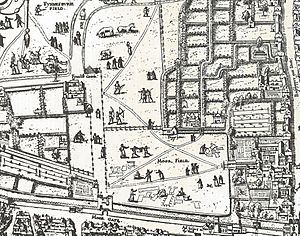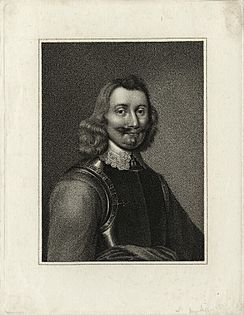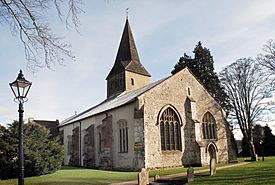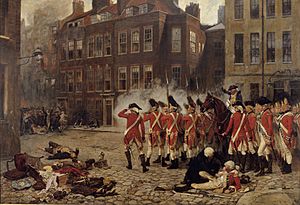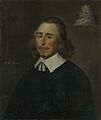London Trained Bands facts for kids
Quick facts for kids London Trained Bands |
|
|---|---|
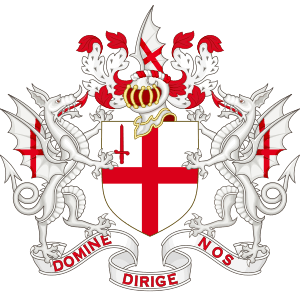
|
|
| Active | 1559–1794 |
| Country | |
| Branch | |
| Role | Infantry |
| Size | 4–6 Regiments + 6 Auxiliary Regiments |
| Garrison/HQ | City of London |
| March | My Lady Greensleeves (alleged) |
| Anniversaries | 20 September (Newbury) |
| Engagements | Suppression of Essex's Rebellion Battle of Turnham Green First Battle of Newbury Siege of Basing House Battle of Alton Battle of Cheriton Battle of Cropredy Bridge Battle of Lostwithiel Second Battle of Newbury Suppression of Venner's Rising Suppression of Gordon Riots |
| Commanders | |
| Notable commanders |
Martin Bond Philip Skippon Sir Richard Browne Sir James Harrington |
The London Trained Bands (LTBs) were a special part-time army in the City of London. They existed from 1559 until 1794. They were like a local defense force, called up when England needed protection. For example, they helped defend the country during the Spanish Armada in 1588.
The LTBs also fought in many important battles during the English Civil War. These included the First and Second Battles of Newbury. They also helped keep order in London during times of trouble.
Contents
- Early History of London's Defenders
- The London Trained Bands are Formed
- The English Civil War and London's Role
- Stopping the Royalists at Turnham Green
- Building London's Defenses
- The London Auxiliaries Join the Fight
- The Relief of Gloucester and First Battle of Newbury
- Fighting in the South (Basing House and Alton)
- More Battles: Cheriton and Cropredy Bridge
- The Lostwithiel Campaign and Second Battle of Newbury
- Changes After the War
- During the Commonwealth and Protectorate
- After the King Returned (Post-Restoration)
- What Happened Next: Successor Units
- Uniforms and Flags
- Traditions and Legacy
- Images for kids
- See also
Early History of London's Defenders
The idea of a local army in England goes way back to the Anglo-Saxons. This old army was called the Fyrd. It was made up of free men from different areas, led by their local Sheriff. This system continued even after the Norman kings took over.
Later, kings made new rules for this army. King Edward I's Statute of Winchester in 1285 was one of these. London's fighters were involved in big events like the Battle of Lewes in 1264. They also defended the city during the Siege of London in 1471.
King Henry VIII wanted England to be stronger. He made laws that said boys and men had to practice archery. Towns also had to set up targets for practice. Moorfields and Finsbury Fields were popular places for Londoners to practice. In 1539, Henry called a "Great Muster" across the country. About 16,000 London fighters marched through the city.
The London Trained Bands are Formed
In 1557, new laws created the county militia. This was a local army led by a Lord Lieutenant chosen by the monarch. In London, the elected Lord Mayor and Aldermen took on this role. They also chose the officers.
Not everyone could be fully trained. So, after 1572, a special group was chosen for the "Trained Bands." These men trained regularly. London's government wanted to reduce its number of trained soldiers, but the Queen's government actually increased it! The city's livery companies (groups of tradesmen) had to help pay for the soldiers and their weapons. Later, the city's wards (local districts) took over this responsibility.
People often made fun of the Trained Bands in other parts of the country. They were sometimes called "Untrained Bands" because they didn't train much. But London was different! Its regiments were well-trained and ready to fight. They even left their businesses for short military campaigns.
The Honourable Artillery Company (HAC) was a group of keen citizens. They learned military drills and studied fighting skills. Many officers for the London Trained Bands came from the HAC. This helped make London's forces some of the best in the country.
Defending Against the Spanish Armada
When England went to war with Spain in 1585, training the militia became very important. By 1588, the LTBs were training twice a week. When the Armada Crisis happened, they were called up on July 23.
The LTBs were organized into four main groups: East, North, West, and South Regiments. In total, there were 40 companies, each with 150 men. This meant 2,000 men had long spears (pikemen) and 4,000 had light guns (calivers). Other areas around London also provided more companies.
The LTBs marched to a big camp at Tilbury. There, Queen Elizabeth gave her famous Tilbury speech on August 9. After the Spanish Armada was defeated, the army at Tilbury went home. The Trained Bands continued to train.
Keeping Order and Preparing for War (1599–1642)
The LTBs were called into action during Essex's Rebellion in 1601. The rebel leader, Robert Devereux, thought the LTBs would support him, but they didn't. Instead, they blocked his way and helped capture him. The LTBs also helped guard London during his trial and execution.
During the reign of King James I, the militia was not given much attention. But in 1614, the government ordered the Lord Mayor to inspect the LTBs and make sure they were ready. By 1616, the four regiments were formally set up. Each had five companies of 300 men.
For many years, the LTBs mostly did ceremonial duties. They also helped keep order during holidays when apprentices could get rowdy. Their officers, however, were very active in the HAC and other military groups.
In 1639 and 1640, the LTBs were called out for the Bishops' Wars. The King wanted 3,000 men to fight outside London. But the City of London said its trained bands could not be forced to serve outside the city. Instead, the LTBs were used to secure the areas around London. Riots against the King's policies were happening often. The LTBs were sometimes reluctant to act against the rioters, as they often agreed with them.
The King and Parliament disagreed over who should control the Trained Bands across the country. This was one of the main reasons for the First English Civil War. Parliament started giving orders directly to a London committee. They even put Philip Skippon in charge of the LTBs. Skippon was already a leader in the HAC.
After the King left London, Skippon led a parade of the LTBs to honor Parliament's leaders. He also took control of the Tower of London.
In February 1642, the LTBs grew to 40 companies of 200 men. They were now organized into six regiments instead of four. These new regiments were named after the color of their flags. Many new officers, mostly from the HAC, were appointed. The regiments were:
- Red Regiment
- White Regiment
- Yellow Regiment
- Blue Regiment
- Green Regiment
- Orange Regiment
The first parade of these six regiments happened on May 10, 1642. Thousands of Londoners and members of Parliament watched.
The English Civil War and London's Role
Once the First English Civil War began in 1642, the Trained Bands outside London were mostly used to find new soldiers and weapons for the main armies. Many soldiers in Parliament's army were from London. Some officers were even former members of the LTBs or HAC.
Parliament was lucky to have the LTBs as a strong backup force. A group of 12 LTB companies was sent to protect Windsor Castle for Parliament.
Stopping the Royalists at Turnham Green
The King's army, led by Prince Rupert, reached Brentford (west of London) on November 11, 1642. Rupert attacked the village and defeated two of Parliament's regiments.
The next day, Philip Skippon gave a speech to the LTBs. He led them out to Turnham Green. They stood ready to fight alongside Parliament's tired soldiers. The King's army saw that they were outnumbered and had fewer guns. Instead of attacking, they retreated under the cover of darkness. The Battle of Turnham Green ended with hardly any fighting. The LTBs had helped save London!
Building London's Defenses
London had grown far beyond its old city walls. During the war, citizens built walls and guard posts across all the streets leading out of the city. The LTBs guarded these posts every night.
During the winter of 1642–43, volunteers built a huge wall and ditch around London and its suburbs. This defense system was called the Lines of Communication. It was about 11 miles (18 km) long and had 23 forts. It was one of the biggest city defenses in Europe at the time. The LTBs took turns manning these forts and key points.
The London Auxiliaries Join the Fight
Guarding these defenses day and night was a lot of work. So, in 1643, London raised six more regiments. These were called the Auxiliaries. They had the same colors as the original regiments and acted like second battalions. More people, including apprentices, could now join. The weapons were provided by the city's trade groups.
When the London Militia Committee took full control in August 1643, it had 18 regiments of foot soldiers, about 20,000 men! Not all could leave the city at once. But during fighting seasons, regiments took turns serving in the field.
The LTBs and Auxiliaries also helped capture suspects in a plot against Parliament. They also guarded prisons and executions. In July 1643, a group of London soldiers defeated Royalists in Kent.
The Relief of Gloucester and First Battle of Newbury
In the summer of 1643, the Royalists were winning many battles. They captured the important port of Bristol and then began to attack Gloucester on August 10. Parliament's main army was too weak to help. But Parliament and city leaders asked London for help. The city agreed to send five regiments, called the City Brigade.
These regiments were much larger than other army units at the time. They marched out on August 23 and joined Parliament's army. With these new soldiers, Parliament's army was strong enough to march through Royalist areas. On September 5, they reached Gloucester. The Royalists were forced to end their attack, and Parliament's army entered Gloucester with much-needed supplies.
On their way back to London, the Royalists caught up with Parliament's army near Newbury. The First Battle of Newbury began on September 20. The Royalists attacked Parliament's soldiers. The London Brigade, led by Skippon, was sent in as a reserve. They helped stabilize the line and pushed back the Royalist cavalry with their long spears. The London soldiers fought bravely, even under heavy fire. They had about 300 wounded and many killed.
The battle ended when it got dark. The Royalists, low on gunpowder, retreated. Parliament's army marched on towards London. The LTBs were harassed by Royalist cavalry, but they drove them off. The City Brigade marched back into London on September 28. They were welcomed as heroes, wearing green branches in their hats to show victory.
Fighting in the South (Basing House and Alton)
Another London brigade was chosen to join Sir William Waller's army. This included the Green Auxiliaries and regiments from Westminster and Tower Hamlets. Many of these soldiers were paid substitutes, as citizens preferred to stay home.
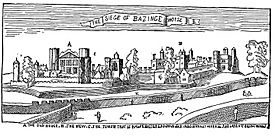
In November 1643, this brigade attacked Basing House. The attack failed, and many Westminster soldiers ran away. They were later fined or imprisoned. The London soldiers then wanted to go home because of the bad weather.
On December 12, Waller persuaded the London Brigade to stay until Christmas. That night, they marched to Alton, Hampshire, where a Royalist group was staying. The Royalists were surprised. The London Brigade attacked the town. They fought their way into St Lawrence's Church, where the Royalists surrendered. After the Battle of Alton, the London Brigade was allowed to go home on December 20.
More Battles: Cheriton and Cropredy Bridge
In December 1643, a new London brigade joined Waller's army. This included the White and Yellow Regiments, who had not yet seen battle. After delays due to snow, they joined Waller's army in March 1644.
On March 29, the Battle of Cheriton began. London musketeers helped secure a wood on the Royalists' flank. The London brigade helped drive back Royalist cavalry attacks. The Royalists eventually retreated. The Londoners then helped capture Bishop's Waltham Palace. After this, the Londoners were eager to go home. They left without orders and returned to London as heroes on April 14.
Later, in May 1644, more London Auxiliary regiments joined Parliament's army. They were involved in skirmishes around Oxford. One brigade, including the Tower Hamlets TBs, fought at the Battle of Cropredy Bridge on June 29. The Tower Hamlets TBs bravely defended a bridge, stopping the Royalists from destroying Parliament's army.

The Lostwithiel Campaign and Second Battle of Newbury
In the summer of 1644, Parliament's army, including London Auxiliaries, marched into Cornwall. But the Royalists trapped them near Lostwithiel. After 13 days, Parliament's army had to surrender. The London Auxiliaries were disarmed and allowed to march away. They returned to London in September.
In October, London provided a fresh brigade for the Second Battle of Newbury. This included the Red and Blue Regiments of LTBs. The London brigade fought with Parliament's army. They held their ground against the Royalists. However, the Royalists managed to escape the trap.
The London regiments then helped besiege Donnington Castle. They also took part in a new attack on Basing House. By December, the London brigade returned to London.
Changes After the War
The Second Newbury campaign was the last time the LTBs saw major fighting in the war. In 1645, Parliament created the New Model Army. This was a professional, full-time army that could fight anywhere. This new army meant the LTBs were no longer needed for big battles.
The LTBs continued to guard London and train. They also manned night patrol posts. In 1647, there was a disagreement between Parliament and the Army. The Army wanted more control. When the Army marched on London, most of the trained bandsmen did not show up. The city leaders gave in, and the New Model Army marched into London.
However, in 1648, during the Second English Civil War, a Royalist group marched on London. They expected Royalists in the city to join them. But Skippon called out the LTBs, and this time they showed up in force. They guarded the city gates, and the Royalists had to go elsewhere.
During the Commonwealth and Protectorate
After the King was executed, England became a Commonwealth and later a Protectorate under Oliver Cromwell. The LTBs continued to guard London. They were on high alert during the Third English Civil War in 1650. New "London Volunteer Regiments" were also raised to help guard the city.
The militia received pay when they were called out. They worked with the New Model Army to keep order. Cromwell appointed new leaders for the LTBs to control civil unrest. The LTBs were not allowed to be used outside London without their permission. When Cromwell died in 1658, the LTBs were part of his funeral procession.
After the King Returned (Post-Restoration)
In 1660, Charles II returned to England and the monarchy was restored. London welcomed him. The LTBs and Auxiliaries lined the route when Charles arrived.
Venner's Rising
In 1661, a radical religious group called the Fifth Monarchists started a rebellion led by Thomas Venner. They tried to take St Paul's Cathedral. The Lord Mayor, Sir Richard Browne, led the Yellow Regiment of LTBs against them. Venner's men retreated.
On January 4, the rebels re-entered the city. There was fierce fighting. The Yellow Regiment chased them and eventually cornered them in buildings. The London soldiers broke in through the roofs and captured them. Venner was later executed.
The Militia is Reformed
The English Militia was re-established in 1661. London had its own law, the City of London Militia Act 1662. This kept the LTBs under the control of the Lord Mayor and Aldermen. The name "Trained Bands" continued to be used in London until 1794.
The LTBs were called out to stop riots by weavers in 1675 and 1689. They also patrolled the streets during times of political tension.
By 1697, the City regiments were:
- Orange Regiment
- White Regiment
- Green Regiment
- Yellow Regiment
- Red Regiment
- Blue Regiment
Each regiment had 8 companies, totaling about 6,770 men.
After 1713, the militia declined in many parts of England. But in London, the six LTB regiments continued. They played a role in city ceremonies. In 1719, it became mandatory for LTB officers and sergeants to be members of the HAC. During the Jacobite Rising of 1745, the LTBs guarded the approaches to London.
The Gordon Riots
The LTBs were on the streets of London during the Gordon Riots in 1780. The Bank of England was a target for the rioters. Regular soldiers and militia defended it. On June 7, the Bank was attacked. The militia fired their guns, killing several rioters and driving them back. After these riots, a permanent guard was stationed at the Bank every night until 1973.
What Happened Next: Successor Units
The London Trained Bands were finally reorganized in 1794. The six traditional regiments were reduced to two: the East London Militia and the West London Militia. Unlike other local armies, one London regiment always had to stay in the city. The other could not go more than 12 miles (19 km) away. Both regiments were given the name "Royal" in 1804.
In 1820, they combined to form the Royal London Militia. Later, in 1881, this unit became the 4th Battalion of the Royal Fusiliers (City of London Regiment). In 1908, it became the 7th (Extra Reserve) Bn, Royal Fusiliers. This battalion even fought in World War I. The militia was officially disbanded in 1953.
Uniforms and Flags
There is a memorial in London to Martin Bond, a captain of the London Trained Bands. It shows him and two musketeers from 1643. They are wearing broad-brimmed hats and bandoliers (belts for ammunition).
People used to think that the trained bandsmen wore colored coats that matched their regiment's name. But there is no proof of this. They probably wore their normal clothes. Pikemen might buy a special leather coat for protection. The colors in the regiment names referred to the large flags carried by each company.
Traditions and Legacy
The 7th (City of London) Battalion, London Regiment, claimed to be connected to the Yellow Regiment of LTBs. However, the true descendants of the LTBs were the 7th Bn Royal Fusiliers.
The 7th Londons adopted the tune My Lady Greensleeves as their slow march. This tune was supposedly linked to the LTBs in 1580. William Shakespeare even mentioned it as a marching tune in his play The Merry Wives of Windsor.
Images for kids
-
The Siege of Basing House by Wenceslaus Hollar.
-
Maj-Gen Richard Browne, afterwards Lord Mayor and Baronet (National Portrait Gallery, London).
See also
- Trained Bands
- Militia (English)
- Militia (Great Britain)
- London Militia
- Royal London Militia
- Southwark Trained Bands


